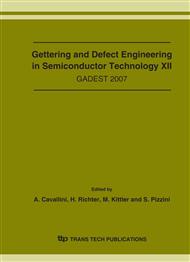p.65
p.71
p.77
p.83
p.89
p.95
p.101
p.107
p.113
Configuration of DV Complexes In Ge: Positron Probing of Ion Cores
Abstract:
Angular correlation of annihilation radiation technique (ACAR) has been used for studying a microstructure of the vacancy-group-V-impurity complexes (DV) formed by irradiation with 60Co γ – rays at Tirr. ≈ 280K in oxygen-lean n-Ge doped with group-V-impurity atoms As, Sb, and Bi. The probability of annihilation of positrons with the core electrons of DV complexes to be reconstructed from ACAR spectra has been analyzed on the basis of Chapman-Kolmogorov formalism; the Coulomb repulsion is proved to regulate the penetration of a positron into Ge4+ and D5+ ion cores. In passing from AsV to SbV and BiV complexes the ion cores D5+ are found to contribute more effectively to the probability of the positron annihilation in the core region. These data correlate well with the augmentation of the entropy of ionization (4S ~ 2,9 ÷ 4,2K) observed by means of capacitance transient techniques with the use of Au-Ge Schottky barriers in the same row of a similar vacancy-impurity complexes. The results obtained by ACAR spectroscopy suggest the full-vacancy configuration of DV pair with relaxation of atoms inward towards the vacancy.
Info:
Periodical:
Pages:
89-94
Citation:
Online since:
October 2007
Price:
Сopyright:
© 2008 Trans Tech Publications Ltd. All Rights Reserved
Share:
Citation:


